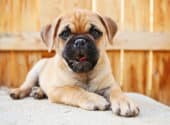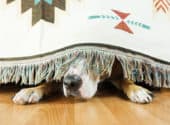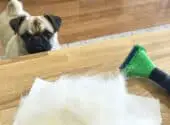The old wives’ tale about size being unimportant is one of the most enduring, and slightly endearing, white lies that successive generations have insisted on passing down to each other.
We all know that size matters, and no one knows that more than the devoted fans of the Teacup Pug. As far as this diminutive dog is concerned, size is the only thing that does matter.
Teacup dogs are a law unto themselves, and the usual rules and guidelines that every dog owner gradually learns while they’re sharing their lives with their canine companions don’t apply to them.
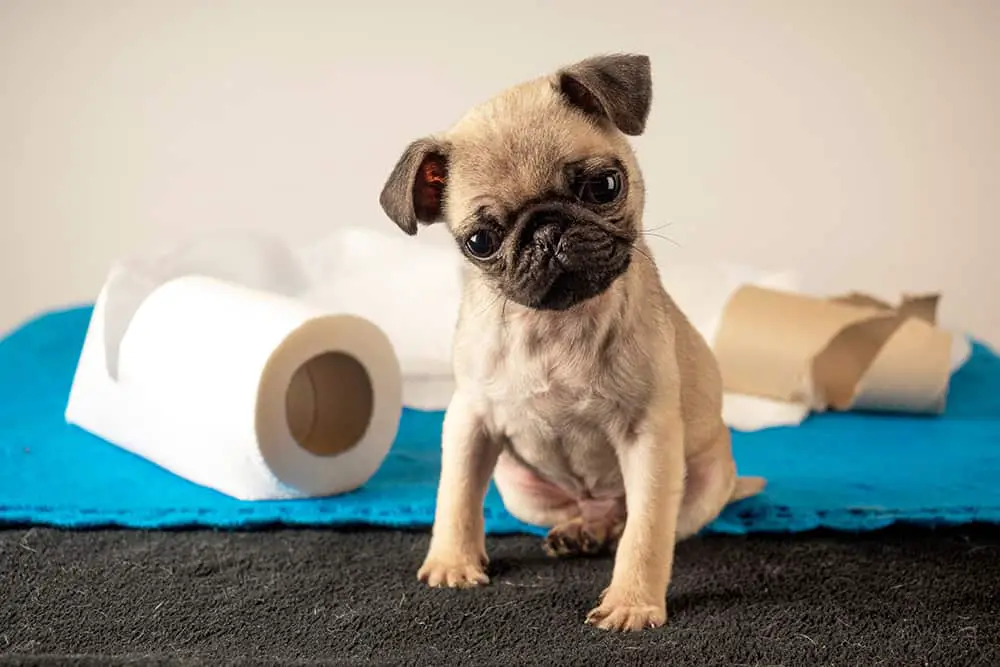
They need the sort of owner who will be completely devoted to them and in return, these tiny dogs will shower their families and friends with affection.
Just because they’re small, it doesn’t mean that these little dogs don’t have the same lupine spirit as their larger canine cousins, they absolutely do. They just choose to demonstrate it in a different way.
The Teacup Pug is a big dog in a tiny dog’s body, and while they’re less physically demanding than other dogs are, they do need an owner who is willing to dedicate the time and effort that they need to look after and care for those unique little dogs.
And if you’re prepared to make that sort of commitment, you’ll soon discover the inescapable truth that every Teacup Pug owner knows. Once you go tiny, nothing else matters.
That’s why we’ve put together this comprehensive guide to the little Pug that could so that you’ll know exactly what to expect from your new best friend when you bring him home.
He may be small, but he’ll need you to know as much about him as you possibly can so that you can both live a long(ish), happy and healthy life together.
But before we plunge headlong into the small world of the teacup pug, there are a couple of things that you’ll need to understand before you start looking for your new pal.
Teacups aren’t recognized as an official breed by the American Kennel Club (AKC), or any kennel organization, no teacup breeds are. The reason they’re not recognized is that they’re the result of designer breeding, in which a less desirable genetic feature is exploited to ensure that a dog has very specific physical features.
Teacup pugs and other teacup “breeds” are the result of breeding two pedigree dogs who suffer from “dwarfism” and are usually the runt, or the smallest dogs in any litter.
And then there’s the issue of Teacup Pugs not actually being pugs at all, as some breeders, in an attempt to guarantee the size of the dog, breed smaller Chihuahuas, and Pugs rather than a pair of smaller Pugs.
The puppies essentially look the same, but they’re not “purebred” Pugs, and as they’re not pedigrees and have been bred to accentuate a physical trait rather than maintain a bloodline, it doesn’t endear the Teacup “Pug” to the AKC and its members.
These dogs don’t fall within the breed specifications laid down by various kennel clubs and are bred to encourage a trait that officially recognized breeders have been actively trying to eliminate.
Teacup breeds are seen as being designer dogs, and they’re bred to fulfill a very distinct set of physical parameters rather than the wellbeing and long-term health of the dog.
Now that you’re aware of some of the breed-centric issues that the Teacup Pug has raised within the canine community, we can move on and start to talk about this teeny tiny dog in far more detail.
The History Of The Teacup Pug
The Pug has an illustrious and long history that can be traced back to the Song Dynasty, which lasted from the Tenth to the Thirteenth Century.
They were the favorite dogs of the Chinese Royal Court for nearly a thousand years and didn’t arrive in Europe until the sixteenth century, where they soon followed the example that they’d set in their native country and became the cherished companions of the nobility and aristocracy.
By the time the Pug finally made it to America, it had been a European mainstay for nearly three hundred years, and it was officially recognized by the American Kennel Club in 1885.
Having said that, there is no documented Teacup history, and no one seems to know, or can even begin to agree on a date when the first Teacup Pug appeared.
The only thing that Pug fans do seem to be able to agree about is that when they did appear, for all intents and purposes, from out of nowhere, anyone and everyone who spent any time in the gossip columns of the National Enquirer, Entertainment Weekly, The LA Times and the New York Post had to have one.
And nothing makes a designer dog as famous as a celebrity endorsement or a well-timed paparazzo photograph.
What Does A Teacup Pug Look Like?
Teacup Pugs look almost exactly the same as a normal Pug does, they’re just a lot smaller than the average Pug.
They’ve got the same flat, wrinkled face, the same small muscular body, large round head, heart-melting eyes, and short curly tails. They’re Pugs who look like they’re been miniaturized with a shrinking ray that the villain in nineteen fifties Science Fiction B-Movie would have used to try and take over the world.
Remember when we mentioned that some breeders have a tendency to favor Chihuahuas as either a father or mother dog to ensure that their Teacups fit their desired size margins?
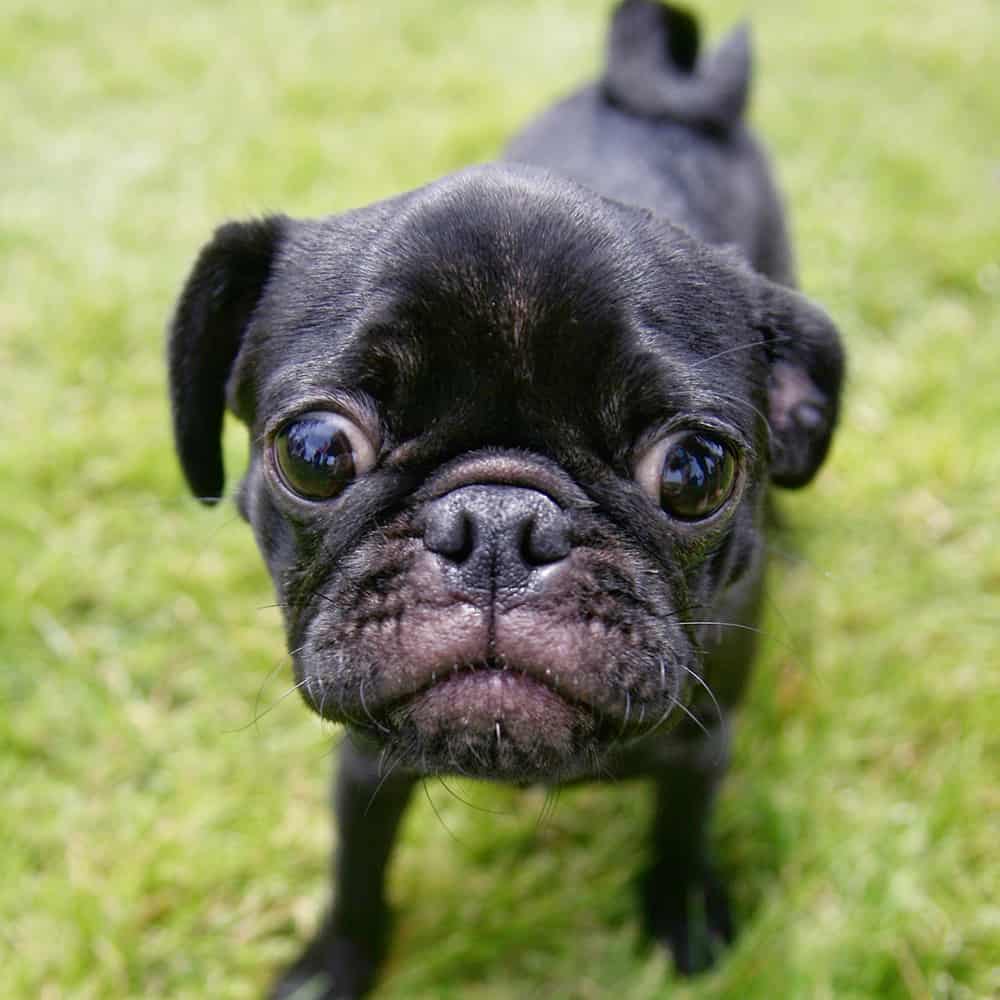
There’s an easy way to tell if a Teacup Pug has any Chi-Chi blood, as their snout will be slightly longer and more pronounced than a normal Pug’s.
It won’t, of course, make any difference to you, but it might make things slightly easier for your tiny dog as being a brachycephalic breed, a slightly longer muzzle, and nose means that they’ll be able to breathe more easily.
There is, as it turns out, an upside to breeders choosing to include a Chihuahua in a Teacup Pugs family tree.
Who’s A Good Looking Boy?
Teacup Pugs, just like their full-size cousins, are handsome dogs. They have the same poise and stance that all Pugs do and their single layer coats come in the five colors of their breed rainbow – black, brown, fawn, silver, and white.
How Small Is A Teacup Pug?
Compared to an average Pug, which is between nine and thirteen inches tall and weighs between ten and fifteen pounds, they’re small. And when we say they’re small, what we really mean is that they’re tiny.
Most Teacup Pugs are, at most, six inches tall at the shoulder and weigh between three and five pounds. In other words, they really are small enough to sit in a teacup. Granted, it’d have to be a pretty big teacup, but they can sit in one.
How Long Do Teacup Pugs Live For?
This is the most heartbreaking news about these teeny tiny dogs, as they defy all of the usual conventions of the canine world. Small dogs usually live a lot longer than big dogs do, but that’s not the case with Teacup Pugs.
All of the inherent health problems that their unusually small size saddle them with mean that they only live for between six and eight years, which is half the life expectancy of an average Pug, as they tend to live between twelve and sixteen years.
It’s A Health Thing
Let’s get straight to the point and tackle the elephant in the Teacup Pug room head-on. They’re not healthy dogs, they’re not as robust and tough as an average Pug is, and they have to deal with all of the same everyday genetic conditions and health woe that their larger counterparts do.
The major issue that every pug has to deal with, regardless of their size, is that they’re brachycephalic. That means that their noises and snouts are smaller, and their airways are more restricted, than other dogs are.
It makes it more difficult for them to breathe after strenuous exercise or when they push themselves too hard, and they can’t breathe as easily as other dogs can when the temperatures start to climb, which makes the breed prone to heatstroke and heart attacks.
Teacup Pugs, because of their flat faces and large, protruding eyes are also susceptible to ocular damage, infection, and cataracts, which can lead to premature blindness. And just like other Pugs, they can be plagued by both coronary and dietary issues, and hip dysplasia, which is a common problem with the breed.
And then there’s the added bonus of the chronic health conditions that a Teacup can inherit if one of its parents is a Chihuahua, which include hydrocephalus and epilepsy.
When you look at the bigger picture, it’s easy to see why a Teacup Pugs’ life is so short, given the uphill health struggle that they have to face throughout their lives.
It’s also easy to understand and see why it’s vitally important to make sure that you take out a pet insurance plan, as you’ll become intimately familiar with the office and waiting room of your closest veterinary surgery if you do decide to become a Teacup Pug parent, and an insurance plan can help to reduce any vet bills and make them far more affordable.
Do Teacup Pugs Shed?
All dogs shed, even teeny, tiny Teacup Pugs, but as they’re a lot smaller than just about every other dog in the canine kingdom and only have a single coat, you won’t have to sweep up a lot of Pug hair.
And in order to make sure that their coats stay healthy and shiny, you’ll need to brush your Teacup Pug for five to ten minutes a couple of times a week. That should be enough to cope, and deal with any loose fur and make sure that they don’t deposit any on your furniture.
Do They Drool? Unfortunately, They Do
Like every other brachycephalic breed, the Teacup Pugs short snout, muzzle, small mouth, and tendency to pant means that it drools.
And it just doesn’t just drool when it’s waiting for its dinner bowl to hit the floor, when it’s begging you to share whatever you’re eating with it or when it just finished drinking, it’ll drool at the drop of a hat and when you least expect it to.
It’s just one of the things that Pugs, no matter how big or small they are, do.
When The Lights Go Down
Teacup Pugs don’t have a lot of energy, and they tend to tire themselves out very quickly which means that they also sleep a lot, and as they’re lap dogs, they’ll spend an inordinate amount of time curled up on your knee.
Which would be fine, if they didn’t also snore, which like all brachycephalic breeds of dog, they do, and you won’t be the first Teacup parent to wonder how such a little dog can make so much noise.
Walking A Teacup Pug
Because they don’t have a high-capacity energy reserve tank, they don’t need a lot of exercises. At most, all your Teacup Pug will need is a thirty-minute walk a day, fifteen minutes in the morning, and fifteen minutes in the evening.
And if you have access to a yard or a garden, most Teacup Pugs are happy and content to just potter and wander around in an outside area and don’t actually need to be exercised, which makes them an ideal companion for anyone who doesn’t have the time to go hiking, or isn’t particularly fond of the great outdoors.
Apartment Life With A Teacup Pug
Because of their lack of exercise drive and their size, Teacup Pugs, as long as they’re taken for a brief walk a couple of times a day, are ideally suited to living in an apartment.
They don’t take up much room and they’d rather curl up on your knee than face the numerous perils of the world outside your front door.
The Teacup Pug And The First Time Owner
After everything that we’ve just told you, you wouldn’t be amiss in thinking that a Teacup Pug would be perfect for a first-time owner. And if it wasn’t for the one glaring character flaw that troubles every Pug, you’d be right.
The problem with any Pug is that they’re stubborn and incredibly wilful, and sometimes they’ll only do what they want to do when they want to do it.
This can make owning one an incredibly frustrating experience for anyone who isn’t used to being around, or dealing with dogs. They may be small and they may be cute, but at the end of the day, a Teacup is still a Pug.
The Teacup Temperament
And for a little good news. Teacups, just like their bigger cousins, are friendly, curious, affectionate, and loyal dogs.
They were originally bred in China to be companion dogs and love nothing more than spending time with and being around their families. All Pugs are outgoing and friendly with everyone they meet, and the Teacup’s lack of size doesn’t have any impact on its natural Pug demeanor.
It’s one of the reasons why Pugs are such highly valued family dogs, as they adore being the center of attention and in the middle of everything that their families do.
Do Teacup Pugs Play Well With Others?
All Pugs are incredibly sociable, and they get on well with other dogs, adore children even seem to have a natural affinity for, and with cats. Even though they love to be around children, given how small they are, Teacup Pugs aren’t best suited to life with toddlers and young children.
They need to be handled with care, and as such should really only live with kids who are old enough to understand how physically delicate the breed is.
Can Teacup Pugs Be Left On Their Own?
Pugs are highly sociable dogs and that makes them prone to separation anxiety, which means that if they’re left alone for extended periods of time they can become destructive and incredibly vocal.
And when they start chewing your slippers, shoes, and furniture and begin barking, they won’t stop until you get home. Which won’t endear you to your neighbors and could leave you with a large and unwanted replacement shoe and furniture bill.
And as Teacup Pugs are so small and delicate, the chances that they could accidentally hurt themselves while you’re out are pretty high. You can leave them by themselves, but we recommend that you do unless you know someone who can look after your Teacup in your absence.
Are Teacup Pugs Noisy?
They’re yappers rather than barkers and will yap at anything that they find exciting or that they think might be a threat or scares them.
And the problem is, once a Pug starts yapping they won’t stop, and will just carry on long after they’ve forgotten what they were originally barking at, and about.
Are Teacup Pugs Intelligent?
Pugs aren’t the sharpest of dogs, and while they can effectively communicate what they want, and are adaptable to changes in their circumstances, they’re not noted for being bright or clever.
But then, when you look as good as a Pug does, being blessed with brains would just be another curse that they’d be forced to deal with.
Are Teacup Pugs Easy To Train?
As we’ve already mentioned Pugs have a natural adaptive intelligence which means that they should be easy to train, but they’re hampered in their desire to please their humans by one, immovable trait. Their stubbornness.
Because they’re single-minded, Pugs and their Teacup cousins can be incredibly difficult to train, and the only way to do it is with perseverance and a reward-based training program.
Are Teacup Pugs Expensive?
They’re a designer breed, and unfortunately, that means that Teacup Pugs are incredibly expensive, and you can expect to pay anywhere between one and three thousand dollars for a puppy.
And they don’t often come up for adoption, as they’re not usually left in local shelters, but they are sometimes left in the care of specialist Pug rescue centers, so you could try giving one of them a call to see if your newest little buddy is just waiting for you to swing by and pick him up.
After all, it’s always more affordable, and more humane, to adopt a dog than it is to shop for one.
Parting Is Such Sweet Teacup Sorrow
That’s it, folks, that’s everything that we know and everything that you need to know to prepare yourself for life with a Teacup Pug.


